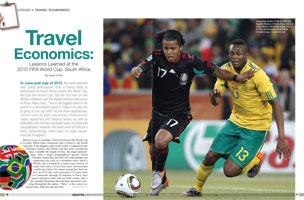
 In June and July of 2010, the world watched with great anticipation (and a heavy dose of skepticism) as South Africa hosted the World Cup. Not just any World Cup, but the first one on the African continent, and the largest event to ever occur in Africa. Many cried, "This is the biggest event in the world! In a third world country? There's no way this is going to turn out well!" As the event approached, rumors came to light concerning infrastructure, roads, equipment and funding issues, as well as difficulties with the key functional areas of travel and transportation. However, the event went off without a hitch; astonishingly, there were no major issues. How did it happen?
In June and July of 2010, the world watched with great anticipation (and a heavy dose of skepticism) as South Africa hosted the World Cup. Not just any World Cup, but the first one on the African continent, and the largest event to ever occur in Africa. Many cried, "This is the biggest event in the world! In a third world country? There's no way this is going to turn out well!" As the event approached, rumors came to light concerning infrastructure, roads, equipment and funding issues, as well as difficulties with the key functional areas of travel and transportation. However, the event went off without a hitch; astonishingly, there were no major issues. How did it happen?
Before we go on, perhaps a short briefing on the World Cup is in order. While many Americans don't realize it, the World Cup truly IS the biggest event in the world. Compared to the Olympic Games, the World Cup has more worldwide fans, is double the length of time, has major sponsorship, and a larger geographical spread. (Each Olympic Games has one host city with perhaps one supporting city such as a mountain town, while a World Cup is hosted by a nation and consists of many host cities.) Every four years, devoted fans worldwide follow the teams around the host nation. In 2010, the event consisted of 32 teams from six continents through 64 matches in thirty days across nine host cities with ten total venues, plus a few hundred thousand international spectators traveling throughout the nation. "Wow," is the correct response here. Add into the mix that organizers do not know which team goes to the next round until the games have been played. In other words, planning for unknowns is an absolute necessity.
While the World Cup is a captivating event, as a sports event organizer, you may be wondering why you're reading about it in Sports Destination Management. Well, my company was involved in the event and we think we can share some insight with you. Because our team began three years prior to the event, we had both front row seats and back stage passes. While we had the fortunate experience of being directly involved with the event's transportation, the reason for discussing it in this forum is that we believe lessons we learned about travel economics pertain to any event, both from observations of others and from things we did and could have done better. As event organizers, we all must play the balancing act: how to successfully pull off the event and keep all stakeholders happy, while meeting our clients' many constraints, including budget, and sticking to our own bottom line. Read on to find out what you can learn about travel and transport economics from our World Cup understanding.
Long Term Investments
 |
| Giovani Dos Santos of Mexico (left) and Kagisho Dikgacoi of South Africa (right) in action during a World Cup match June 11, 2010 in Johannesburg, South Africa. © Diademimages - Dreamstime.com |
Travel and transport organizers need to begin well in advance of the event. It is never too early to start building vital relationships with police, local officials, governing bodies, et cetera. A vital step for any event is to identify all stakeholders from the start, find out what has been done already, and determine stakeholders' needs and who is paying for what services and goods. In South Africa, by coordinating with all stakeholders, and being friendly with police and venue managers from the beginning, trust was built. At points, police and other officials shared equipment (i.e. barricades, cones) with organizers and even security personnel at little or no cost. Just as vital was the information shared.
We learned that sometimes we can do it ourselves. Sometimes we need others to help. Building relationships early is one of the absolute best things you can do to run a successful sporting event.
Know Your Market
Thousands of foreigners came into South Africa to work for the World Cup in some capacity. Some alternative housing options were found in some of the lesser known neighborhoods and areas "off the beaten path," such as renting private homes and boarding houses. Housing costs can be reduced by nearly 50 percent and team members can have more enjoyable experiences than staying in hotels. Going without a kitchen for 60 days is tougher than you think.
 Oftentimes event organizers plan and manage events in a city or region that isn't exactly "home." We recommend that you start early, learn the area and traffic patterns, run routes between your venues and proposed hotels at different times of day, et cetera. You never know what you might notice that would never cross your mind if you were doing an internet search. Most importantly, talk to people! Ask questions!You will find ways to reduce costs that you never considered.
Oftentimes event organizers plan and manage events in a city or region that isn't exactly "home." We recommend that you start early, learn the area and traffic patterns, run routes between your venues and proposed hotels at different times of day, et cetera. You never know what you might notice that would never cross your mind if you were doing an internet search. Most importantly, talk to people! Ask questions!You will find ways to reduce costs that you never considered.
Supply and Demand
With such a large event and with planning starting years in advance, peoples' needs changed over time.Particularly as operations got closer, sometimes things changed several times per day! If hearing about these needs hadn't happened quickly enough; service providers wouldn't have had time to react. By changing behavior, talking to clients more, visiting their offices more, and being more receptive, over time organizers were much better able to anticipate needs and move quickly to accommodate them.
No matter the size of the sporting event, talk to your clients! Call them just to say "Hi." They may share vital information that they wouldn't necessarily have called or emailed you to discuss. This will greatly enhance your ability to determine their needs, reduce overbooking and more.
Divisions of Labor
An event of World Cup proportions often lends itself to a significant amount of staff at "discounted pay rates," in the form of volunteers. One of the biggest challenges in South Africa was that hundreds less volunteers were available than planned for, and many volunteers were appointed late and hadn't been trained. Some considered hiring fully paid staff. However, by using appropriate placement and timing of printed materials, a reduction in the overall number of staff needed, whether paid or volunteer, occurred. At times remaining staff was assigned in a different way than originally planned, to a beneficial end.
 Learn to use your resources wisely, and reduce costs. From printed communication, such as fliers or brochures as well as signage in vehicles and hotels, to timely, effective communication between staff, you can reduce personnel costs and even find volunteers for your own events. Just do your best to hire and train them early.
Learn to use your resources wisely, and reduce costs. From printed communication, such as fliers or brochures as well as signage in vehicles and hotels, to timely, effective communication between staff, you can reduce personnel costs and even find volunteers for your own events. Just do your best to hire and train them early.
Opportunity Cost
Any time you buy in bulk, you pay less per item, right? Well, no.Unfortunately, some vendors raise costs surrounding events. In South Africa this occurred in many forms, from flight costs to hotel rooms to rental cars. Those service providers who were in country years before the event were able to determine market rates at "off times," and then to use their experience and relationships to bargain with vendors and bring costs down.
Whether your attendees are flying, being bused, or driving in, you can save big when you book equipment, hotel rooms and seats early. Oftentimes just asking for a discount will result in getting one, particularly when you're talking about a large number of any item or service. Compare rates and tell vendors what you're being offered by their competitors.
Economic Efficiency
During the World Cup significant amounts of money were saved by examining anticipated travel patterns of such groups as teams, officials and media, and then maximized long haul trips by sending vehicles out with one group and back with another, rather than two different one way trips. This enabled a maximization of equipment usage. This also ensued with staff. Given that some host cities' operations were over after 12 of the 30 event days, money was saved by re-assigning team members at the necessary venues for later, more popular events such as the final matches.
 For your sporting event, the same lessons are relevant. Maximize vehicle and equipment utilization by looking ahead at areas like Park & Ride shuttles, timing for spectators, officials' schedules, and more. You might find ways to use the same vehicles on multiple runs, rather than having some vehicles idle.
For your sporting event, the same lessons are relevant. Maximize vehicle and equipment utilization by looking ahead at areas like Park & Ride shuttles, timing for spectators, officials' schedules, and more. You might find ways to use the same vehicles on multiple runs, rather than having some vehicles idle.
Every event must have the following two conditions: people have to show up, and someone has to foot the bill.Thus, event organizers must determine how to induce attendees to the event, provide a way of getting around, and meet the client's budget. We find that no matter the end user, whether VIP or spectator, media member or athlete, and whether the event is regional or international, it is possible to provide safe and flawless execution while keeping costs to a minimum. Using a few principles from our Microeconomics class certainly didn't hurt.

